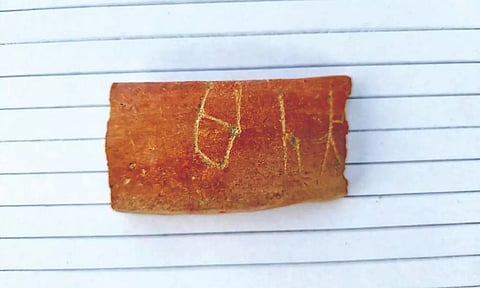

CHENNAI: The Archaeological Survey of India (ASI) recently unearthed around 800 artefacts including pottery with Tamil-Brahmi script originated 12,000 years ago at Vadakkupattu, Kancheepuram district.
Speaking to DT Next, M Kalimuthu, Superintending Archaeologist, ASI said that the pot with Brahmi inscriptions in Vadakkupattu is a significant finding. Three letters ‘Maththi’ were written on this pot shell. So far, potsherds with Tamil-Brahmi inscriptions have been found only in places like Pattaraiperumbudur in northern Tamil Nadu. It may belong to the first century BCE.
“We started our second phase excavation on May 19, 2023. Six archaeologists, 20 labourers, one research scholar and a few Madras University students are working here. We found around 800 artefacts in all three layers. The upper layer belongs to the Chola era. The lower layer belongs to the early Pallava era (275 BCE). This site may have been a site of Mesolithic manufacturability. The Vadakkupattu finds show continuous habitation for several thousand years. The new evidence shows it is a culturally and archaeologically important site,” he added.
Speaking about the findings, R Ramesh, an Assistant Archeologist in charge of the Vadakkupattu excavation site, said that the ASI was astonished to find, at a lower layer of a 70-centimetre pit, first century BCE (More than 10,000 years ago) artefacts including pottery with Tamil-Brahmi script, a flint female figure, a flint stamp, a broken flint doll, a vase, a flint necklace, coral beads, terracotta toys and beads, iron and copper objects.
“So far we have gone up to 70 centimetres. We will further go up to 10 centimetres in the next month. Our second phase of excavation work will continue till September. As per the typological study, the tools may have been made roughly 12,000 years ago. We have sent all these findings for analysis. Carbon dating and thermoluminescence dating will reveal the exact age of the tools. It is unique to find stone tools, artefacts and ornaments belonging to four different eras in a single place,” added Ramesh.
Earlier in the first phase of excavation, the ASI found Roman amphora shards and glass beads indicating active trade with Rome (Sangam era, more than 2,000 years ago) and the team discovered sculptures in the surrounding area which belong to the Pallava era.